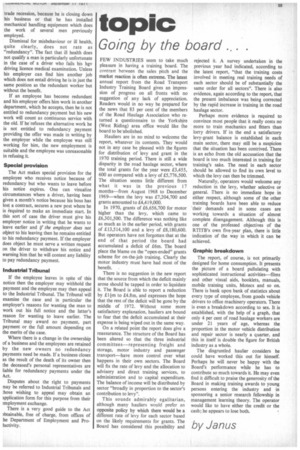topic
Page 65

If you've noticed an error in this article please click here to report it so we can fix it.
Going by the board ...
FEW INDUSTRIES seem to take much pleasure in having a training board. The contrast between the sales pitch and the market reaction is often extreme. The latest annual report from the Road Transport Industry Training Board gives an impression of progress on all fronts with no suggestion of any lack of appreciation. Readers would in no way be prepared for the news that 83 per cent of the members of the Road Haulage Association who returned a questionnaire to the Yorkshire (West Riding) area office would like file board to be 'abolished.
Hauliers are in no mind to welcome the report, whatever its contents. They would not in any case be pleased with the figures for distribution of levy and grant in the 1970 training period. There is still a wide disparity in the road haulage sector, where the total grants for the year were /3,455, 600 as compared with a levy of 0,776,500. The situation seems little different from what it was in the previous 17 months—from August 1968 to December 1969—when the levy was £7,204,700 and grants amounted to £4,419,000.
In 1970, grants of £6,656,700 for motor higher than the levy, which came to £6,301,500. The difference was nothing like as much as in the earlier period, with grants of £.13,514,100 and a levy of £8,180,600. But operators have not forgotten that at the end of that period the board had accumulated a deficit of £6m. The board place the blame on the "open-ended" grants scheme for on-the-job training. Clearly the motor industry must have had most of the benefit.
There is no suggestion in the new report that the source from which the deficit mainly arose should be tapped in order to liquidate it. The Board is able to report a reduction by LIfin to £4.8m, and expresses the hope that the rest of the deficit will be gone by the middle of 1972. Without some more satisfactory explanation, hauliers are bound to fear that the deficit accumulated at their expense is being wiped out in the same way.
On a related point the report does give a reassurance. The structure of the Board has been altered so that the three industrial committees--representing freight and storage, motor industry and passenger transport—have more control over what happens in their own sectors. The Board will fix the rate of levy and the allocation to advisory and direct training services, to administration and to capital expenditure. The balance of income will be distributed by sector "broadly in proportion to the sector's contribution to levy".
This sounds admirably egalitarian, although many hauliers would prefer an opposite policy by which there would be a different rate of levy for each sector based on the likely requirements for grants. The Board has considered this possibility and rejected it. A survey undertaken in the previous year had indicated, according to the latest report, "that the training costs involved in meeting real training needs of each sector should be of substantially the same order for all sectors". There is also evidence, again according to the report, that the present imbalance was being corrected by the rapid increase in training in the road haulage sector.
Perhaps more evidence is required to convince most people that it really costs no more to train mechanics and fitters than lorry drivers. If in the end a satisfactory levy-grant balance is established in each main sector, there may still be a suspicion that the situation has been contrived. There is an echo from the old accusation that the board is too much interested in training for training's sake. The need in each sector should be allowed to find its own level to which the levy can then be trimmed.
Naturally, operators would welcome any reduction in the levy, whether selective or general. There is no immediate hope in either respect, although some of the other training boards have been able to reduce • their demands and in some cases are working towards a situation of almost complete disengagement. Although this is one of the professed objectives of the RTITB's own five-year plan, there is little indication of the way in which it can be achieved.
Graphic breakdown The report, of course, is not primarily designed for home consumption. It presents the picture of a board pullulating with sophisticated instructional activities—films and other visual aids, booklets, manuals, mobile training units, Motecs and so on, There is bank upon bank of statistics about every type of employee, from goods vehicle drivers to office machinery operators. There is even a breakdown according to sex. It is established, with the help of a graph, that only 4 per cent of road haulage workers are under 21 years of age, whereas the proportion in the motor vehicle distribution and repair sector is nearly a quarter, and this in itself is double the figure for British industry as a whole.
The disgruntled haulier considers he could have worked this out for himself. Perhaps he will never be happy with the Board's performance while he has to contribute so much towards it. He may even find it difficult to praise the generosity of the Board in making training awards to young persons entering the industry and in sponsoring a senior research fellowship in management learning theory. The operator would like to have either the credit or the cash; he appears to lose both.
by Janus




















































































































